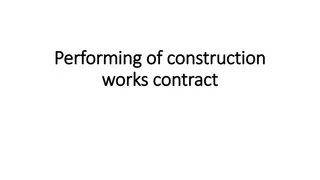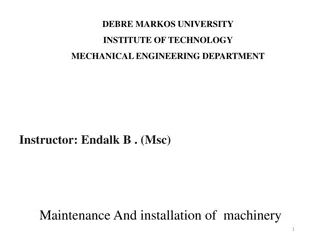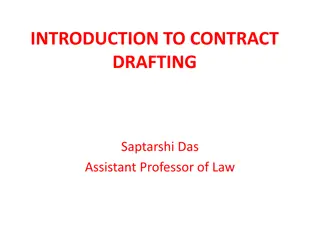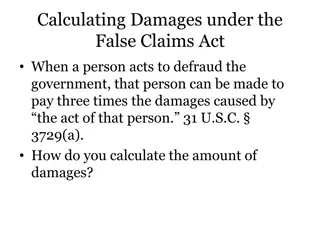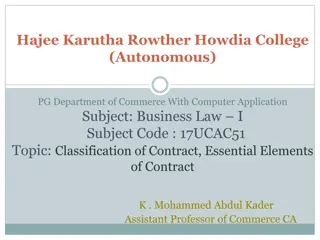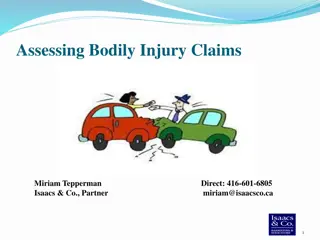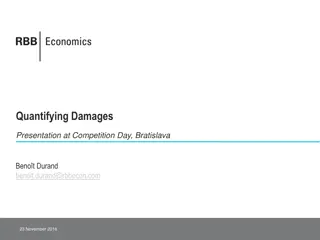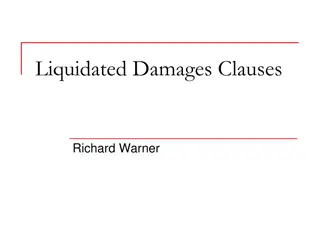Understanding Liquidated Damages in Construction Contracts
Liquidated damages in construction contracts serve as predetermined compensation for delays in project completion, distinct from penalties for nonperformance. Contractors may have payments withheld if unsatisfactory progress causes time overruns. The SE-330 and OSE Manual outline procedures for assessing and withholding liquidated damages, separate from change orders. The SE-395 form and SE-550 certificate play roles in finalizing project completion and warranty periods. Understanding actual versus planned liquidated damages is crucial for project management and risk assessment.
Download Presentation

Please find below an Image/Link to download the presentation.
The content on the website is provided AS IS for your information and personal use only. It may not be sold, licensed, or shared on other websites without obtaining consent from the author. Download presentation by click this link. If you encounter any issues during the download, it is possible that the publisher has removed the file from their server.
E N D
Presentation Transcript
SE-330, Lump Sum Bid Form (2016 Edition) 9. TIME OF CONTRACT PERFORMANCE AND LIQUIDATED DAMAGES b) LIQUIDATED DAMAGES Bidder further agrees that from the compensation to be paid, the Owner shall retain as Liquidated Damages the amount of $_________ for each Calendar Day the actual construction time required to achieve Substantial Completion exceeds the specified or adjusted time for Substantial Completion as provided in the Contract Documents. This amount is intended by the parties as the predetermined measure of compensation for actual damages, not as a penalty for nonperformance.
OSE Manual (2016 edition) 7.16 7.16.2 unsatisfactory job progress has caused or will cause the actual contract time to exceed the specified (or adjusted) contract time, and if the contract includes a provision for assessing actual or liquidated damages, payment shall be withheld from the contractor in amounts necessary to cover the anticipated damages. WITHHOLDING PAYMENT TO CONTRACTORS When the Agency has determined to its satisfaction that
OSE Manual (more) 7.16.2 (A) Such amounts to cover damages for late completion are in addition to retainage, the balance for incomplete work and any amounts withheld for other reasons stated in the contract.
OSE Manual (and more) 7.16.2 (B) Actual or Liquidated Damages to be assessed a contractor are NOT to be incorporated into a change order, as they are not changing the value of the contract. They are only to be listed as a line item deduction from the amount paid on the pay application.
SE-395 Of course we have a form for that.
OSE Manual (OK, one more) 7.18.3 Declarations of Substantial Completion D. Issuance of the SE-550, Certificate of Substantial Completion, terminates the Agency s right to impose Liquidated Damages (if any) and establishes the beginning date for the warranty period.
As-Planned Liquidated Damages $500 per day? $1,000 per day? Actual Damages lost revenue (e.g., lost rent, income, business, profits) from loss of use Injury to business and reputation extended cost of Owner s employees (administration) overhead extended Insurance interest (construction financing) costs or delays suffered by others unable to commence work interest (prejudgment, post-judgment) lost productivity extended A/E costs
Liquidated Damages: How much? LD provisions are not enforceable if they are found to constitute a penalty.
Liquidated Damages: How much (more)? Two things: The actual damages contemplated at the time of the agreement would be uncertain and difficult to determine with exactness The amount fixed is not out of all proportion to the probable loss
Liquidated Damages: How much (already)? lost revenue (e.g., lost rent, income, business, profits) from loss of use Injury to business and reputation extended cost of Owner s employees (administration) overhead extended Insurance interest (construction financing) costs or delays suffered by others unable to commence work interest (prejudgment, post-judgment) lost productivity extended A/E costs
Three things to prove 1. The contract work was not substantially completed by the contract completion date (plus any time extensions granted); 2. The liquidated damages are due under the contract; and 3. The period measured for assessing the LD's was appropriate.
Three things for the contractor 1. The delay was not her responsibility 2. The delay was excusable 3. The LD provision is unenforceable
Excusable Delay: A201 2007 SCOSE 8.3.1 If the Contractor is delayed at any time in the commencement or progress of the Work by an act or neglect of the Owner or Architect, or of an employee of either, or of a separate contractor employed by the Owner; or by changes ordered in the Work; or by labor disputes, fire, unusual delay in deliveries, unavoidable casualties or other causes beyond the control of the Contractor and any subcontractor at any tier; or by delay authorized by the Owner pending dispute resolution; or by other causes that the Architect determines may justify delay, then to the extent such delay will prevent the Contractor from achieving Substantial Completion within the Contract Time and provided the delay (1) is not caused by the fault or negligence of the Contractor or a subcontractor at any tier and (2) is not due to unusual delay in the delivery of supplies, machinery, equipment, or services when such supplies, machinery, equipment, or services were obtainable from other sources in sufficient time for the Contractor to meet the required delivery, the Contract Time shall be extended by Change Order for such reasonable time as the Architect may determine.
Concurrent Delay In the case at hand, there is ample evidence that both Clemson and EllisDon contributed to the overall delay of the Project. Although Clemson did not delay the project to the extent claimed by EllisDon, Clemson nonetheless clearly contributed to the delay. As set forth above, the design changes and lead/asbestos abatement issues added to the scope of the Project, and more likely than not delayed the completion of the Project, even if those issues weren't represented, at the time, as being on the critical path. EllisDon wasn't without its own problems and issues: in addition to failing to provide accurate and up to date CPM schedules, EllisDon more likely than not contributed to the delay by its problems with the concrete flooring, and its subcontractors contributed to significant delays to the greenhouse construction. The Panel finds that both parties significantly contributed to the delays, that both parties attempted (sometimes successfully) to mitigate the other parties' cause of delay, that EllisDon misreported and misrepresented the delay, that Clemson occasionally failed to timely address the claims and/or the possibility of delay, and that the post-dispute testimony regarding the schedule analysis and CPM has been used to both support and refute each party's delay. Panel Case No. 2005-2(VIII)
Unenforceable Penalty Has to be pretty gross Rarely seen in construction contracts Unlikely that agency would try Unlikely that OSE would miss it
As-Built Actual Damages lost revenue (e.g., lost rent, income, business, profits) from loss of use Injury to business and reputation extended cost of Owner s employees (administration) overhead interest (construction financing) costs or delays suffered by others unable to commence work interest (prejudgment, post-judgment) lost productivity extended A/E costs 15.1.6.1 Waiver of Listed Damages lost revenue and profit for lost use of the property losses resulting from injury to business or reputation additional or escalated overhead and administration expenses additional financing costs costs suffered by a third party unable to commence work any interest, except to the extent allowed by Section 13.6 (Interest) costs resulting from lost productivity or efficiency.
As-Built Actual Damages lost revenue (e.g., lost rent, income, business, profits) from loss of use Injury to business and reputation extended cost of Owner s employees (administration) overhead interest (construction financing) costs or delays suffered by others unable to commence work interest (prejudgment, post-judgment) lost productivity extended A/E costs 15.1.6.1 Waiver of Listed Damages lost revenue and profit for lost use of the property losses resulting from injury to business or reputation additional or escalated overhead and administration expenses additional financing costs costs suffered by a third party unable to commence work any interest, except to the extent allowed by Section 13.6 (Interest) costs resulting from lost productivity or efficiency.
Miscellany What Hank Wall said Don t be a *%$#@ Don t be penny wise



